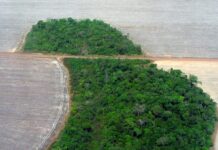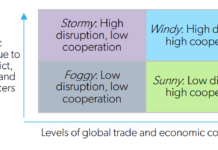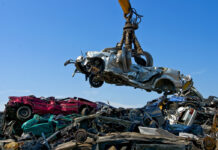Researcher Jennifer Hynes recently gave a frightening presentation about the situation in the Arctic and the odds that things will rapidly spiral out of control, escalating into runaway global warming a few decades from now.
Why Sea Ice Matters

The above slide from the presentation warns about the danger of earthquakes causing methane hydrate destabilization (from: Smoke Blankets North America). As the map below shows, 77 M4+ earthquakes hit locations around Greenland in the year 2014 up until August 4.

“We’re seeing the ice just shrivel away now,” says Jennifer Hynes in the following video.
At least 70 percent of the heat in our planetary system is absorbed by the oceans and a substantial amount of this heat has gone into the melting of Arctic ice.
The Arctic Methane Monster’s Rapid Rise (Jennifer Hynes)
Published August 5, 2014
Standard YouTube Licence
The image below shows sea surface temperature anomalies in the Arctic at August 7, 2014.

Warm water is carried into the Arctic Ocean by the Gulf Stream, as illustrated by the image below.

The image shows how the Gulf Stream brings warm water to the edge of the sea ice. Waters close to Svalbard reached temperatures as high as 15.6°C (60.1°F) on August 8, 2014 (green circle). Note that what the image shows are sea surface temperatures only. At greater depths (say 300 m), warm water is pushed through the Greenland Sea by the Gulf Stream. Since the passage west of Svalbard is rather shallow, a lot of this warm water comes to the surface there. The high sea surface temperatures west of Svalbard thus indicate that the Gulf Stream is carrying very warm water (warmer than 15°C) at greater depths and is pushing this underneath the sea ice north of Svalbard.
The situation is dire and calls for comprehensive and effective action, as discussed at the Climate Plan blog and as illustrated by the image below.

This article was previously posted in Arctic News.



















I wonder how we could relocate the methane clathrates, do you think scientists are working on this now? I hope so! It all seems so like too much to do in a short period of time but like my dad always said, “It’s when your hardest hit that you must not quit!”. This would probably be a good question to ask Sam in the interview. After all, we got ourselves into this mess maybe we can figure a way out!
Sam does such a great job on his Arctic News blog. I look forward to your discussion with him. He’s been writing about methane and the Arctic for so long. I have a hard time getting my head around the enormity of the methane problem. The PowerPoint presentation/video by Jennifer Hynes presents her message in a factual and graphic way but “her tone didn’t totally match her message” a friend of mine told me.
I ask anyone who reads this to tweet it. It makes a very good strategic point.
http://www.motherearthnews.com/nature-and-environment/problem-with-environmentalists.aspx#axzz3AQ5HzxYL
Thanks Anonymous – the article does make a good point and that is “no one follows a pessimist. We’ve spent far too much time confessing our sins and assigning our scarlet letters. We’ve invested far too little time visualizing successful outcomes.”
You raise a good point.
Also, this is awesome and a huge step forward.
http://www.greenbuildermedia.com/news/nanoparticle-breakthrough-may-make-paint-on-solar-a-reality?_hsenc=p2ANqtz-9_2s3WdSx3_ETuOkokFcxDPN_9ZcgHSWk8EEqWoq3w0tadB8ALBBe7pxIuOnJg3SJseqQX7PqfwsOUxYwY3iGy5m-4eg&_hsmi=13656373&utm_campaign=Solar&utm_content=7126500&utm_medium=social&utm_source=twitter
Anonymous – thanks for sharing these links on nano-particles and paint-on solar potential. Wow!
I really think your point about pessimism is a valid one, anonymous! Unfortunately, we can easily point the finger at those who do “wrong” in the world… it is not so easy to show them how to do things “right,” especially when we have few answers for correcting the after-effects of human development.
Trying to stop the escape of methane seems a daunting task and seems to imply pessimism is a bit of a mild reaction… the problem seems a bit like trying to stop the fizz of a coca cola drink once it is in the glass… how on earth do we stop the ice from melting? It is like trying to put a genie back in the bottle isn’t it?
Jennifer Hynes paints a very bleak picture of methane release in the Arctic. Indeed, there is little room for anything but pessimism. Is it reversible or are we way past that point of no return?
Nano particles may be the only option available for eating up the methane hydrates that are poised to be released from the Tundra. I am glad that this is being looked into. Unless something is done with these, those emissions will generate run away rapid climate change when they start releasing in mass.
In my novel, still looking for a publisher so will divulge little. I use an earthquake on the northern periphery of the Mid Atlantic Ridge to cause an event I labeled Big Thunder. That is a cascading event that causes most of the ice from Greenland to fall into the ocean within two weeks. The sonic vibration of the quake causes the mullens in the ice to break apart, not unlike a sledge hammer hits air pockets in concrete to break it.
A very valuable post and related links, thanks Rolly.
Just finished the article on nano particles, I jumped the gun in my comment. However, I think the idea of using nano particles to eat up methane hydrates is something that should be considered. Of course the hard part would be somehow in controlling them to a specific location parameter.
Is the use of nano particles for eating up methane hydrates fictitious or real?
In other words, is that concept in your yet-to-be published novel or is it in fact a scientifically proven practice that will be used to face the methane monster that is awakening is the Arctic?
Slightly off-topic in that it is a different source of Methane, but I just watched two BBC Horizon Documentaries hosted by Michael Mosley who has pointed out the vast problems with our current meat consumption (World Wide). He indicated that we should half our consumption of meat or the world will see a huge increase of methane from cattle, (the highest producer of methane in our food chain). Currently a third of all methane produced in the world comes from livestock raised for human consumption. This is a huge figure and actually outstrips the methane produced by transportation (combustion engines). It doesn’t take a genius to figure out that the health benefits from a reduced meat diet are also very profound!
You will find many interesting articles about the burden of cattle and meat products on our society in Boomers Speaking Out. Look for posts by Cassie Ito who is a vegan and sometimes posts material from this group – The Elephant in the Room is a Cow.
http://gulfresearchinitiative.org/study-confirms-methane-eating-bacteria-contributed-carbon-entering-food-web/
Just found this website article about bacteria who convert methane into biomass carbon.
Nature always finds a way to deal with everything, but we must find methods to harness the good effects only (life sustaining).
Hopefully the technological race to find methods (bacteria, fossil fuel elimination and green energy with neutral or beneficial by-products only) to balance our atmosphere can be found before our air is inadequate for human life to continue. If we don’t, the seas will rise, landmass will decrease, the planet gasses will be predominantly methane based and only bacteria and small adapting creatures will survive. It will be like turning back the clock to the dawn of life on our planet – and we won’t be in it!
I do hold a ray of hope that somehow, societies will eventually do the right thing… just when is what concerns me?
Of course we all know that nature or planet Earth will survive global warming. Species, including humans, will perish but not mother Earth. As you point out, nature finds a way to deal with obstacles through disease, floods, earthquakes, bacteria, etc. We can learn from harnessing some of nature’s processes. As they say, “the truth is out there.”
Thanks Colette for sharing your observations.
Rolly, sorry – I can’t go to your “Boomers Speaking Out” link… it is on facebook and I don’t ever go there. I am not a member of facebook and never will be. I really distrust most social media sites – especially the one’s favoured by the majority! Maybe I just haven’t moved with the times, but I find it is letting the whole world watch you and you just don’t know who is watching!